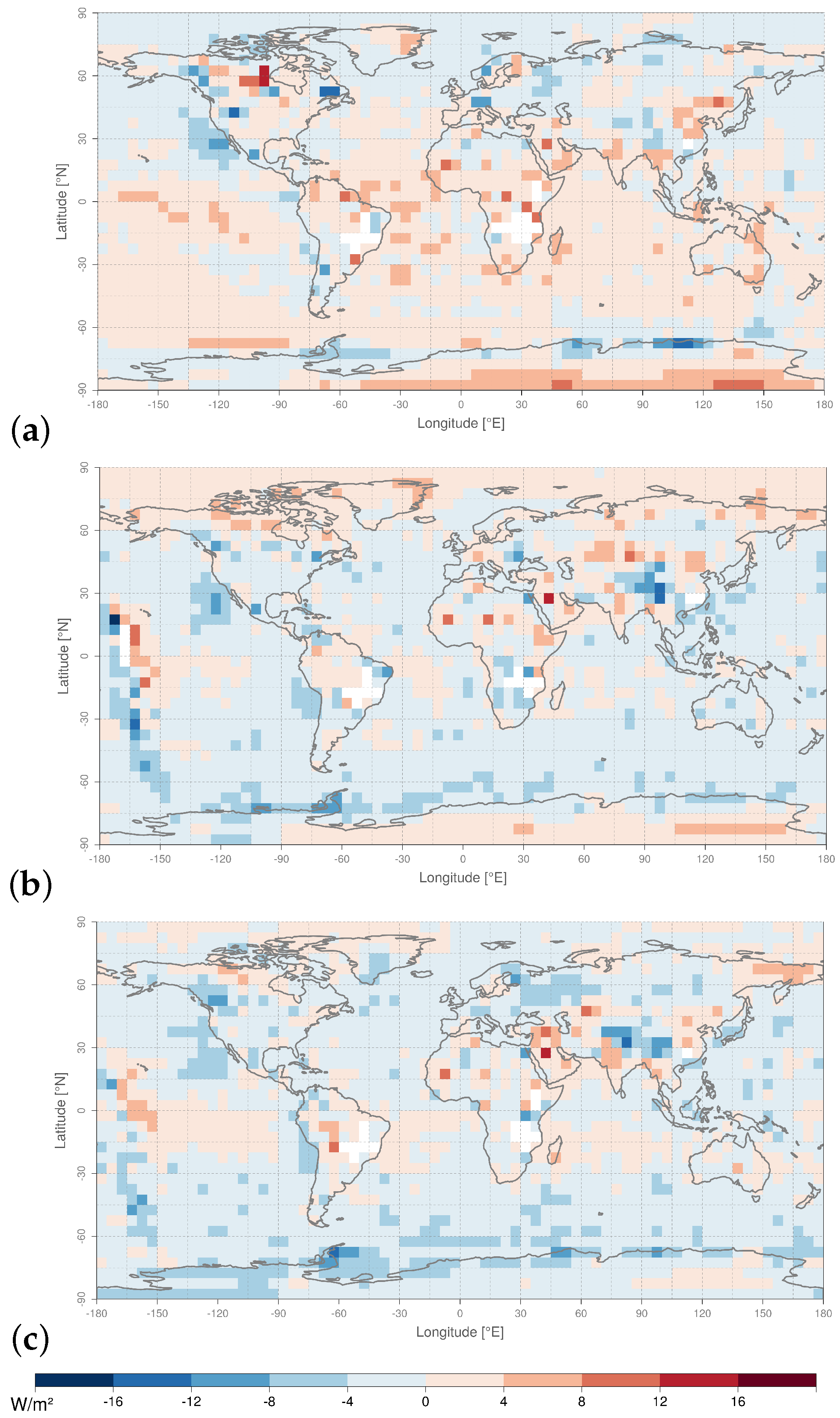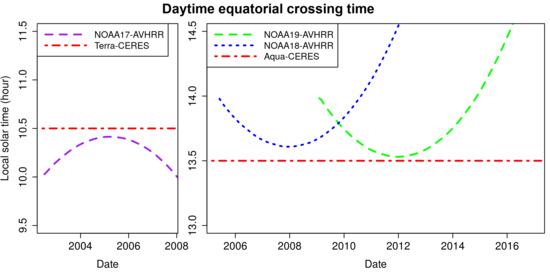1. Introduction
Broadband measurements of top-of-atmosphere (TOA) reflected solar flux and emitted thermal flux are essential climate variables of which a high-quality data record of satellite measurements with sufficient length (“Climate Data Record” or CDR) is needed by, among others, the climate modeling community (for validation purposes), and preferably spanning several decades [
1]. However, apart from instrument-specific broadband measurement campaigns (e.g., CERES, 2000-present [
2]) and regional datasets based on geostationary satellites (e.g., Meteosat-based, 1983–2015 [
3]), to date no harmonized global CDR dating back several decades exists. An alternative method is to rely on existing global long-term CDRs of harmonized narrowband reflectance (FCDRs), e.g., from the Advanced Very High Resolution Radiometer (AVHRR) instrument [
4,
5], and transform these measurements into broadband quantities [
6]. This study aims to establish robust relations between the long-term record of narrowband AVHRR measurements, and the relatively recent state-of-the-art broadband measurements from CERES: these results allow the generation of a global, long-term, broadband energy balance dataset, that would fit the needs of the climate modeling and monitoring community.
Narrowband-to-Broadband (NTB) corrections can be developed in two different ways [
7]: (a) data sets with pairs of collocated, coangular and simultaneous narrowband (i.e., spectral) and broadband observations (also referred to as “
matched NTB pairs”) can empirically be analyzed with regression methods, or (b) theoretical simulations of NTB corrections using sophisticated radiation models may be used [
8,
9]. Here we focus on the first, empirical method, for which there are basically three possibilities of obtaining matched NTB pairs:
A first possibility is that the narrowband and broadband instruments are located on the same satellite. In this case, all matched NTB pairs are per definition highly collocated, coangular, and simultaneous. Examples include CZCS and ERB on Nimbus-7 satellite [
10], AVHRR and ERBE on NOAA-9 satellite [
11,
12], SEVIRI and GERB on Meteosat satellite [
3]. While this is obviously the easiest way to obtain a large database of matched NTB pairs, the instrument combinations are limited.
A second possibility is to combine a broadband instrument located on a polar orbiting satellite (e.g., ERB, ERBE, CERES, ScaRaB) with a narrowband instrument located on a geostationary satellite (e.g., VISSR, SEVIRI). The geostationary satellite provides a fixed field of view with a relatively frequent temporal sampling. However, the coangularity criteria have as effect that the matching is restricted to certain regions, e.g., to the tropics when combining SEVIRI with cross-track CERES [
13]. Examples include GOES2/VISSR to Nimbus7/ERB [
14], Meteosat2/MVIRI to NOAA9/ERB [
15], GOES7/VISSR to Meteor/ScaRaB [
16], MSG1/SEVIRI to Terra-Aqua/CERES [
13].
Finally, the narrowband and broadband sensors can be located on different polar orbiting satellites. This is rather challenging since both satellites are moving independently from each other and chances of simultaneous collocated and coangular measurements are rare, except if both orbital planes coincide and their speed (altitude) is significantly different to allow frequent catch-ups. Probably due to these specific requirements, this possibility is barely reported in the literature.
A brief overview of existing empirical NTB conversions for AVHRR is given in the review paper by Godøy and Eastwood [
7]. The following studies are discussed, where AVHRR is used for planetary albedo determination: Wydick et al. [
17] collocated AVHRR (NOAA-7) to ERB (Nimbus-7), but this study does not really belong to any of the mentioned methods since the narrowband (1981) and broadband (1978–1980) observations are not simultaneous. Li and Leighton [
11] and Hucek and Jacobowitz [
12] collocated AVHRR to ERBE, on the same satellite NOAA-9 (possibility 1).
This paper aims to improve on the last two mentioned studies by making new regressions between AVHRR and CERES, with the most notable advancement being the use of CERES Ed.4 broadband radiance products which, compared to ERBE, performs better due to several instrumental and processing improvements such as a higher resolution, better scene identification, more accurate auxiliary data (e.g., sea ice), etc. [
18]. Furthermore, more detailed scene types are distinguished (e.g., “forest”, “grass”, or “savannas” instead of just “land”), for each of which a separate NTB regression is derived. Relating AVHRR narrowband to CERES broadband reflectance necessarily means a choice for the third empirical NTB possibility in the above mentioned framework.
Early studies proposed a linear regression that was solely dependent on the narrowband reflectances [
11,
12,
14,
17,
19]. The equation used to relate narrowband reflectance (AVHRR channels 0.6
m and 0.8
m) to broadband reflectance (
) typically takes the following form:
where
are the regression coefficients and
stands for “
true isotropic reflectance” [
4], also known as “
Lambertian reflectance” [
20], here simply referred to as
reflectance. The values are expressed as percentage, with a range of 0–100. In subsequent studies, however, the regression parameters were found to depend moderately on solar zenith angle (SZA;
) [
21]. These studies therefore included
as additional parameter [
16,
22,
23]. Feng and Leighton [
23] furthermore found a dependency on viewing zenith angle (VZA;
). Built on this knowledge, the current study includes the SZA-dependency in the same way as Minnis et al. [
22] and adds the VZA-dependency [
23], resulting in the following regression equation:
The inverse of the cosine being a good approximation for the atmospheric path. While the first two of above mentioned studies [
16,
22] removed anisotropy by applying a narrowband angular directional model (ADM), prior to the NTB conversion, the latter study [
23] argued against this practice: it prevents the user from applying an ADM of his choice, e.g., anticipating on future improved ADMs. Their point of view is largely followed in this study, in which no
a priori angular correction is applied. The resulting
can then be used in a broadband ADM of choice (e.g., [
24,
25,
26], or anticipated future ADMs) to remove anisotropy and ultimately obtain the real hemispherical albedo and flux.
2. Data
The broadband measurements are taken from the instantaneous footprint data of the CERES instrument [
27] onboard satellites Terra FM1 and Aqua FM3 (
Single Scanner Footprint TOA/Surface Fluxes and Clouds edition 4A [
28]). Apart from the actual broadband reflectance, also included are geophysical variables (e.g., cloud mask) simultaneously recorded by the accompanying MODIS imager and aggregated to CERES resolution. These will be compared to geophysical variables from AVHRR, to verify whether the matched NTB pair also has identical conditions (apart from the purely temporal-geometrical conditions). Footprint size and shape are spatially variable: cross-track and along-track dimensions increase with viewing zenith angle (
) due to an increasingly spread-out projected area, which is even more magnified by the earth’s curvature. Assuming a spherical pixel with diameter of 32 km at nadir (PSF with 95% energy cutoff [
29]), at
its dimensions reach ~212 km (cross-track) and ~71 km (along-track).
The narrowband measurements are taken from the AVHRR instrument [
30] onboard NOAA-17,-18,-19 satellites, from which an FCDR is created with
Global Area Coverage Level-1c data created using the PyGAC processor [
5]. This data set is supplemented with geophysical variables (such as cloud mask, sea ice concentration, etc.) remapped on the same grid [
31]. The data have a spatial resolution of 4 km at nadir, but similar to CERES SSF, pixel size and shape are subject to biaxial deformation with increasing viewing zenith angle.
The analysis time period has been selected by examining the orbital planes of Terra/Aqua and NOAA satellites: the former have a true sun-synchronous orbit (with daytime equatorial crossing times of ~10:30 and ~13:30 LST) whereas the latter suffer from orbital drift (
Figure 1). The orbital planes coincide around January 2005 (NOAA-17), 2008 (NOAA-18) and 2012 (NOAA-19), which then provides the necessary conditions for having frequent matched NTB pairs, i.e., simultaneous, collocated, and coangular. Since coinciding orbital planes of AVHRR- and CERES-carrying satellites did not occur outside these three time periods, this study analyses an unprecedented exhaustive amount of matched NTB pairs. Combining satellites with deviating orbital planes is not efficient, since there is only a marginal addition of NTB pairs at a high computational cost. This is illustrated by a small test on January 2012: the combination Aqua+NOAA19 (coinciding) results in 4.124.334 matched NTB pairs, whereas Aqua+NOAA18 (~1h off) generates only 99.605 pairs, or 2.4%, which furthermore occur in two limited high-latitude bands. To account for seasonal variability in spectral properties of some land cover types (such as vegetation or sea-ice), the full annual cycle is considered. Therefore, a range of at least +/−6 months is chosen around January, ending up with the periods given in
Table 1. The long time span of a full year furthermore enables regressions per surface type, as the sample size must be large enough within each of these groups, and finally it also allows splitting off a smaller subset serving as independent observations for validation purposes.
5. Conclusions
This paper establishes conversions between narrowband and broadband reflectances observed by respectively the AVHRR and CERES instruments. This is achieved by using empirical relations in a large data set of collocated, coangular and simultaneous AVHRR-CERES observation pairs. Specific orbital conditions for the AVHRR- and CERES-carrying satellites are required, which seriously narrows down the temporal range of potential matched pairs. A data survey has been performed using all available data for an unprecedented observation matching between both instruments.
Multivariate linear regressions are performed for 15 surface types and 3 cloud cover classes, resulting in regression coefficients for 45 scene types. As a result, for each combination of AVHRR reflectances in channels 1 and 2, for a given scene type, a CERES-like broadband reflectance can be estimated. The linear regressions were found to be accurate, as demonstrated by the regression statistics: adjusted > 0.9 and relative RMS residual () below 3% for almost all clear-sky and overcast scene types, which is a significant improvement compared to previous works in the literature.
The added value of scene-dependent models was extensively demonstrated for regression calibration (better fit) as well as for validation (lower bias and ). In addition, this study shows that the inclusion of solar and viewing zenith angle as predictors increases goodness-of-fit and lowers , and furthermore proves necessary to avoid sampling-based model biases.
Validation of the regression models is done first by applying them on a validation subset (20% of pairs with strict matching criteria). The results indicate an overall good performance, with similar to the calibration-, and the flux-equivalent Mean Bias () close to zero. A second validation approach makes use of a much expanded database with global coverage (obtained by relaxing matching criteria), allowing a spatially-explicit analysis and calculation of global mean statistics.
Error analysis is performed with three measures: Precision is given by the standard error of residuals, which is found very small (<0.03%). Stability is calculated by stratifying the data set according to the AVHRR-CERES instrument combination. The analysis reveals systematic instrument-specific biases with an order of (NOAAA19+Aqua) > (NOAA18+Aqua) > (NOAA17+Terra): this is illustrated by for all-sky conditions (+0.32, −0.86, −1.42 Wm), stressing the need for a well calibrated FCDR. Finally, accuracy is quantified as regional uncertainty at 1 standard deviation on a 5 × 5 grid (RMS bias), which is estimated for clear-sky and overcast conditions at respectively 1.8 and 2.3 Wm (instantaneous); this corresponds with 0.7 and 0.9 Wm on daily mean time scale, which is compliant with the GCOS requirements of 1 Wm.













